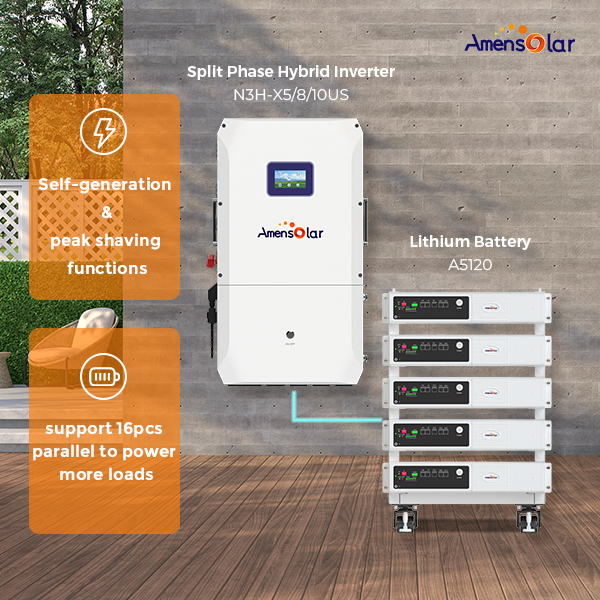The difference between single-phase inverters and split-phase inverters is fundamental in understanding how they operate within electrical systems. This distinction is particularly important for residential solar energy setups, as it influences efficiency, compatibility with home appliances, and overall energy management. Below is a detailed exploration of the two types of inverters.
1. Basic Definitions
Single-Phase Inverter
A single-phase inverter converts direct current (DC) from solar panels or batteries into alternating current (AC) with a single-phase output. This inverter typically provides 120V AC, making it suitable for smaller loads that don't require extensive power.
Split-Phase Inverter
A split-phase inverter, on the other hand, outputs two 120V AC lines that are 180 degrees out of phase with each other. This configuration allows for both 120V and 240V output, accommodating a wider range of appliances, particularly those that demand higher power.


2. Electrical Characteristics
Output Voltage
Single-Phase Inverter: Outputs a single voltage level, usually 120V. It is straightforward and is commonly used in areas where only low-power appliances are needed.
Split-Phase Inverter: Outputs two 120V lines. The combination of these can provide 240V, making it versatile for powering both standard household appliances and larger equipment, such as electric dryers and ovens.
Phase Relationship
Single-Phase: Consists of one alternating current waveform. This is ideal for small electrical loads, but it can struggle with balancing heavier loads, especially in larger homes.
Split-Phase: Involves two alternating current waveforms. The phase difference allows for more efficient distribution of electrical loads, making it easier to manage power needs in larger systems.

3. Applications
Residential Use
Single-Phase Inverters: Best suited for smaller homes or apartments that primarily use low-power devices. They are common in rural areas where electricity demand is lower.
Split-Phase Inverters: Ideal for standard North American homes that use a variety of appliances. The ability to provide both 120V and 240V makes them suitable for a broader range of household needs.
Commercial Use
Single-Phase Inverters: Less common in commercial settings due to their limitations in power output.
Split-Phase Inverters: Often found in commercial applications that require versatile power options. Their capability to handle larger loads makes them valuable in businesses with significant electrical demands.


4. Efficiency and Performance
Energy Conversion Efficiency
Single-Phase Inverter: Generally efficient for low-power applications but may experience losses when attempting to manage higher loads.
Split-Phase Inverter: Typically offers higher efficiency in larger systems, as it can balance loads more effectively and reduce the risk of overloading individual circuits.
Load Management
Single-Phase: Can struggle with uneven load distribution, leading to potential performance issues or failures.
Split-Phase: Better at managing different loads simultaneously, providing a more stable electrical output and reducing the risk of circuit overload.

5. Installation Considerations
Complexity
Single-Phase Inverter: Generally easier to install due to its simpler design. Suitable for DIY installations in small homes.
Split-Phase Inverter: More complex to install, requiring careful consideration of home wiring and load balancing. Professional installation is often recommended.
System Size
Single-Phase Inverter: Limited in scale; best for smaller solar setups that don’t require significant power.
Split-Phase Inverter: More scalable, allowing for the addition of more solar panels and batteries without significant redesign.

6. Cost Implications
Initial Investment
Single-Phase Inverter: Typically less expensive due to simpler technology and lower power capabilities.
Split-Phase Inverter: Higher initial cost, reflecting their greater capacity and versatility in handling diverse loads.
Long-Term Savings
Single-Phase: May result in higher electricity costs over time due to inefficiencies with larger loads.
Split-Phase: Potential for greater long-term savings by effectively managing energy use and enabling net metering for excess energy production.

7. Conclusion
In summary, the choice between a single-phase inverter and a split-phase inverter largely depends on the specific power needs of a home or business. Single-phase inverters are suitable for smaller, less demanding applications, while split-phase inverters provide greater versatility, efficiency, and the ability to manage higher loads. As renewable energy systems become increasingly prevalent, understanding these differences is crucial for optimizing energy use and maximizing savings.

When considering a solar energy system, it is essential to assess not only the inverter type but also the overall energy requirements and future growth potential of the installation. This comprehensive understanding will lead to informed decisions that enhance both performance and sustainability in energy management.
Post time: Sep-21-2024








